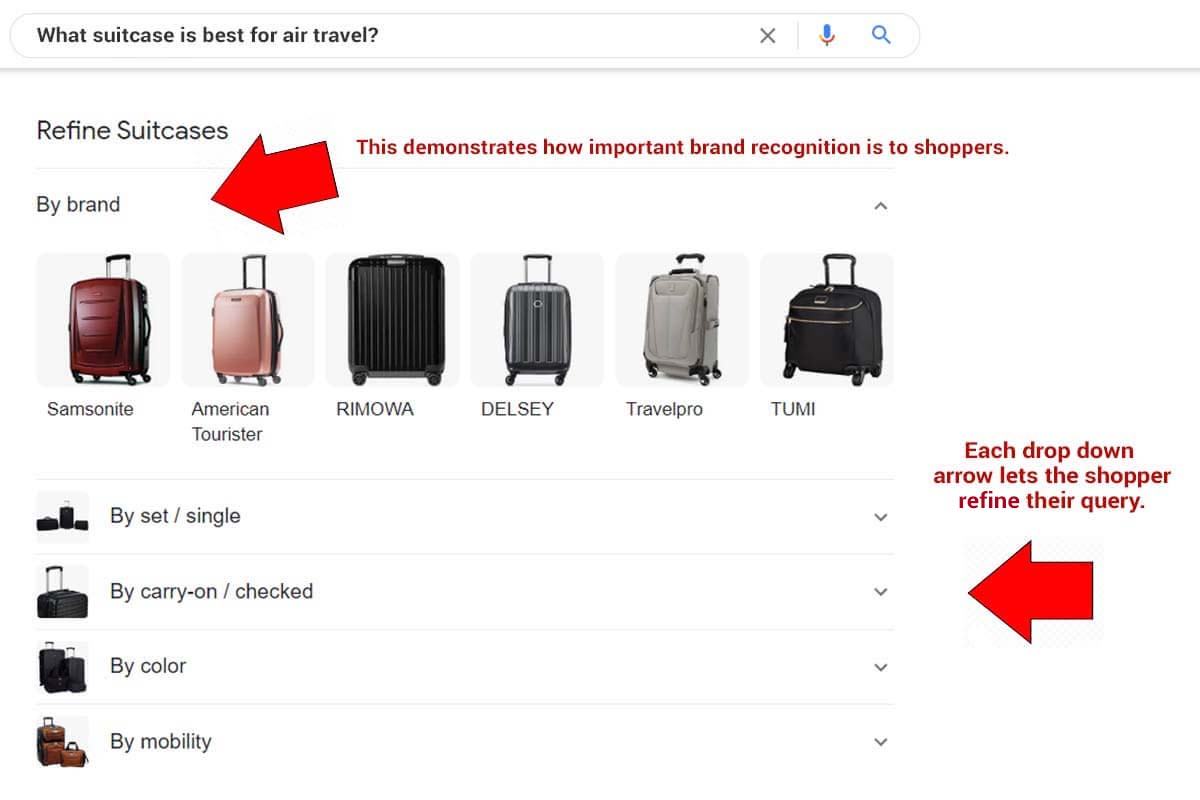Google Shopping Results: Visualized & Personalized AI Shopping in 2025
Updated 1.8.2025
The Google visual shopping experience for consumers wanting seamless multi-device experiences is rapidly expanding to show more product and shopping options.
It is exciting to see additional highly-visual Google search engine result pages (SERPs) become more robust. They offer a more comprehensive selection of product images that shoppers can further filter by viewing thumbnail images. For some time, Google Shopping results have let buyers sort or filter by factors like price, product category, and brand. Today, those search filters are vastly expanding and empowering the consumer to find what they want faster.
Table of Contents
- Generative AI and Personalized Shopping Experiences
- Buy on Google
- How To Get Your Products Displaying in Google’s Shopping Graph
- Google Shopping is a Robust Service for Comparison Shoppers
- What is the Google Shopping Graph?
- What are Sales on the SERP?
- How Google “Shop by image” Works
- Visually-Rich Google SERP Features Assist Shoppers
- How to Optimize your Products for Winning Rich Results
- New Google Shopping Features in 2023
- Shopping Tabs Listing Feature and Store Icons
- CONCLUSION: Shoppers Can Benefit Significantly from AI Product SERPs
This article will help small business owners, SEOs, and marketers tailor their product pages for better user engagement. Here’s where things are going:
Generative AI and Personalized Shopping Experiences
The focus is on how Generative AI shopping impacts the shopper.
Google Shopping Graph Gemini Models: As of October 2024, Google AI Search paired 45 billion product listings in Google’s Shopping Graph with Gemini models to transform the online shopping experience with a new, personalized shopping home. Google AI Search added labels to the product detail side panel when users click on a product in the Google Search popular products grid. The labels feature undergoes ongoing testing: sometimes it displays with a “most popular” and “best price” label in a colored background.
Google Product Knowledge Panel:Google is becoming buyers 2025 shopping category page. It’s “aggregate” Product Detail Page offers the Product Knowledge Panel for specific product queries. This increases ways that brands and retailers can rank their product description pages. It lets shoppers quickly browse and purchase the most compatible product.
Shop with Google Lens. When shoppers find a product They want to buy, they can take a photo and use Google Lens advanced AI models. This leverages Google’s shopping graph to identify the exact item, and display purchase options. Organic search results are often combined with shopping ads on the same SERP.
Improve your chances for future wins in Gen AI shopping by updating your marketing plan for 2025.
Buy on Google
Formerly known as Shopping Actions on Google SERPs
Google shopping actions are changing how customers shop. Google offers buyers a ‘shop deals’ banner for many United States queries. This is why you should ensure that your product grids and Merchant Center product data is currently accurate.
A price slider filter for products is also frequently displayed in search results. Additionally, a Google Search store button filter helps buyers filter by retailer merchants. When trying to rank well in Google’s organic product grids, optimizing your product titles and subheaders with precise keyword matches from a searcher’s query can offer immediate improvements. When a query is quite competitive, effective ways to improve your visibility can be obtained with various factors impacting the algorithm.
What to consider when starting with Google Shopping Actions:
- Product information: Include product images and a product identifier, such as a GTIN, UPC, EAN, JAN, or ISBN.
- Business information: Include your address, EIN, and customer service contact.
- Branding: Include a hex cod, ID code, and logo for your storefront.
- Accuracy: Outdated product details and statistics can hurt you. Back up all your factual statements on product claims. A factual claim means that the marketer gives a concrete promise or makes a claim about the product’s properties or effects
- Add related categories: Each shopping platform offers unique ways to implement related product categories; this assists nearby shopping features in local search.
- Company refund and return policies: This builds trust and demonstrates that you understand what buyers what to know.
REMINDER: Resolve all technical SEO issues on e-Commerce pages to increase your helpfulness aspect to buyers.
How To Get Your Products Displaying in Google’s Shopping Graph
Improve product data quality with AI
Before when selling products on Google, it was necessary to invest money and put in significant effort. Meaning, often small businesses could not appear on Google. With the free listing, small businesses are no longer as reliant on Google’s pay-to-play model. Now, everyone can sell products directly on Google property.
Artificial intelligence is helpful for improving product data quality. It quickly, and typically accurately, detects anomalies and errors and optimizes data cleansing processes. AI learns from user feedback and already published data for its data cleansing capabilities. This improved data quality helps refine the accuracy and relevance of your product data, thereby increasing the effectiveness of your advertising campaigns.
Steps to enable shopping results within a Google Merchant Center account
- Create your Google Merchant account.
- Upload your product(s).
- Adhere to the correct listings format.
- Establish and publish your business policies.
- Read and accept the terms and conditions.
- Link your Google Ads account.
- Check it frequently and make updates and all needed corrections.
The steps above help you better manage how your ads display in search results.
Google Shopping is a Robust Service for Comparison Shoppers
A Search Engine Result Pages Analysis provides fresh insights on how product category pages can be augmented to increase chances of being included in Google SERP product carousels. Since shopping searches are now filled with more product images. this means your business needs to know how to shop on the SERP for visual shopping queries. Google continues to introduce SERP changes to make shopping more eye-catching, user-friendly, and able to make visual filter selections when beginning to browse for an item. Websites designed for seamless multi-device experiences results are seeing improved visibility in shopping SERPs.
Shopping on Google has become a full-featured way to find products right in organic search. It may be time to reassess the quality, format, and size of product images on your site and how you represent your services.
According to Think with Google, more than 90% of Americans use, or would consider using, augmented reality (AR) for shopping. 45% of shoppers use Google to research a purchase they intend to make in a physical store. 61% of consumers say Google Lens elevates in-store shopping.
What is the Google Shopping Graph?
The Google Shopping Graph functions similarly to the Knowledge Graph. However, it is just for products. Linked product data and node relationships are organized so that respective product entities and the edges make shopping easier for buyers.
This makes Google Shopping Graph Optimization a higher priority for e-commerce priority for e-commerce SEO. Newer Generative AI technology that seeks to empower better shopping experiences is built on Google’s Shopping Graph. At this time, it has over 35 billion product listings. No other similar dataset is as comprehensive and dynamically updating.
This means that your seller’s products, brand entity building, consumer reviews, and inventory available are all improved on the SERP.
Testings indicate shoppers use Google’s new features, such as the carousel-style display for pre-purchase searches. Users can scroll horizontally through multiple image-rich information tiles and like its interactive feature. Google’s Shopping Graph showcases product details, including prices, ratings, availability, and images. It’s aimed at providing a more engaging and informative Generative AI search experience.
Google shop powered with Google AI
Mewer Google Shopping experiences use AI to intelligently show the most relevant products for users queries. This benefits the shopper by speeding up and simplifying shoppers’ research. Whether you are moving to AI-driven campaigns or aligning your marketing to shifting client strategies, your efforts need to help shoppers using AI Search.
To rank within free product listing results, a clean, current, and robust Google data feed is important. Avoid linking to product pages in your feed that are mid-journey and not the final destination. This mistake is easy to fix, making the user’s shopping experience more efficient.
Larger e-commerce sites need to control parameters to assist AI in getting it right. Otherwise, multiple URLs for the same product can confuse. However, it’s important to be aware that this feature depends on schema enhanced retail web pages. Having valid SEO schema markup supports user’s shopping queries.
What are Sales on the SERP?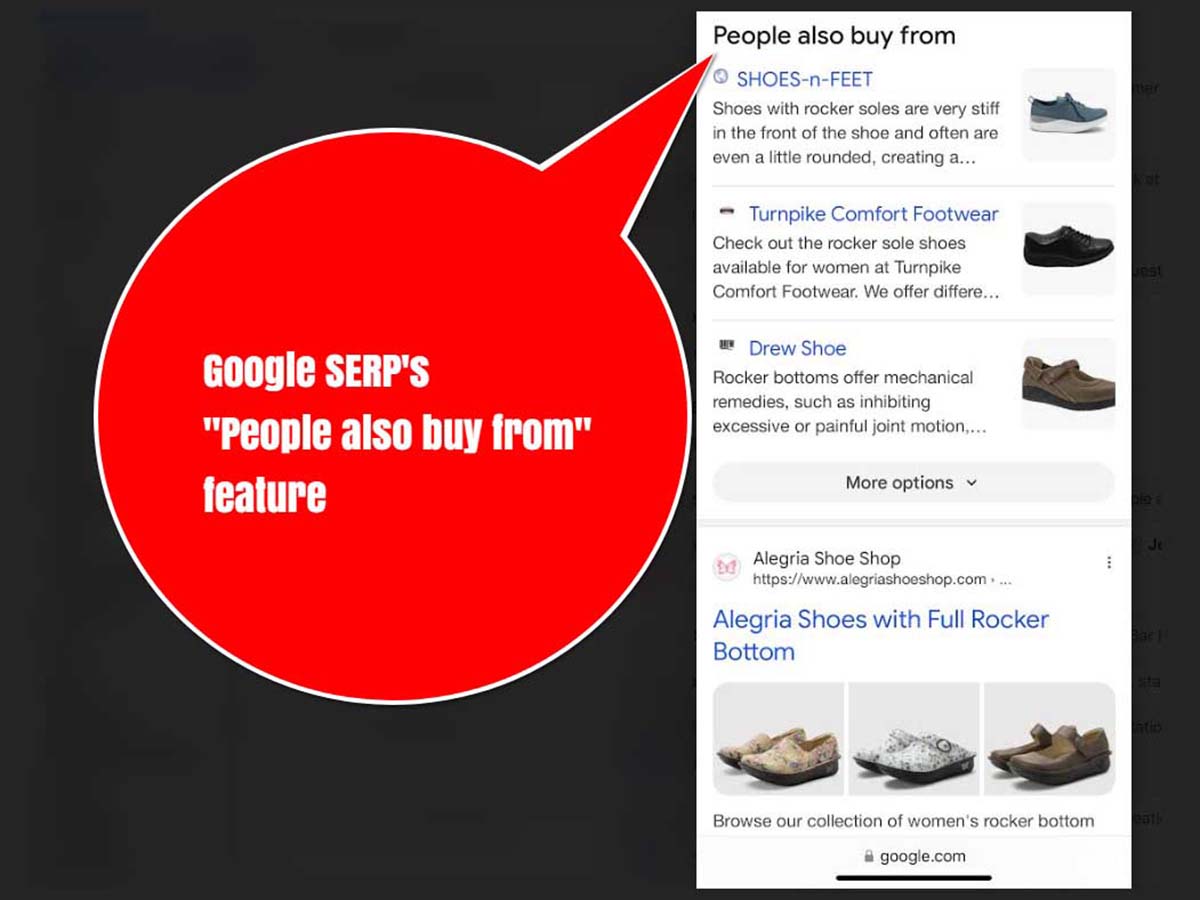
We call “Sales on the SERP” when a potential consumer engages a business through immediate SERPs versus the traditional blue links.
Lead Form Extension: On-the SERP sales may come from a lead form extension triggered by Google AdWords, for example. These are currently possible in Search, Video, and Discovery and convert potential customers without directing them to a business website.
Direct Calls: When your phone number is provided in a highly visible way on the SERP, many shoppers prefer picking up the phone and reaching your sales department.
Google Knowledge Graph: Product images and descriptions can be added directly within your Google Business Profile (GBP). You can also track and identify these GBP listing product leads by adding UTM tracking code. As the “owner” of this profile, you don’t have to worry about another PR or domain editor misunderstanding the URL extension or removing it.
Quick Answers: There are now many ways shoppers can obtain fast answers to questions asked along the buyers’ journey. For example, individuals may reach your product page through a People Also Ask Box click, Product Knowledge Panel, or from a Similar Products SERP feature.
How Google “Shop by image” Works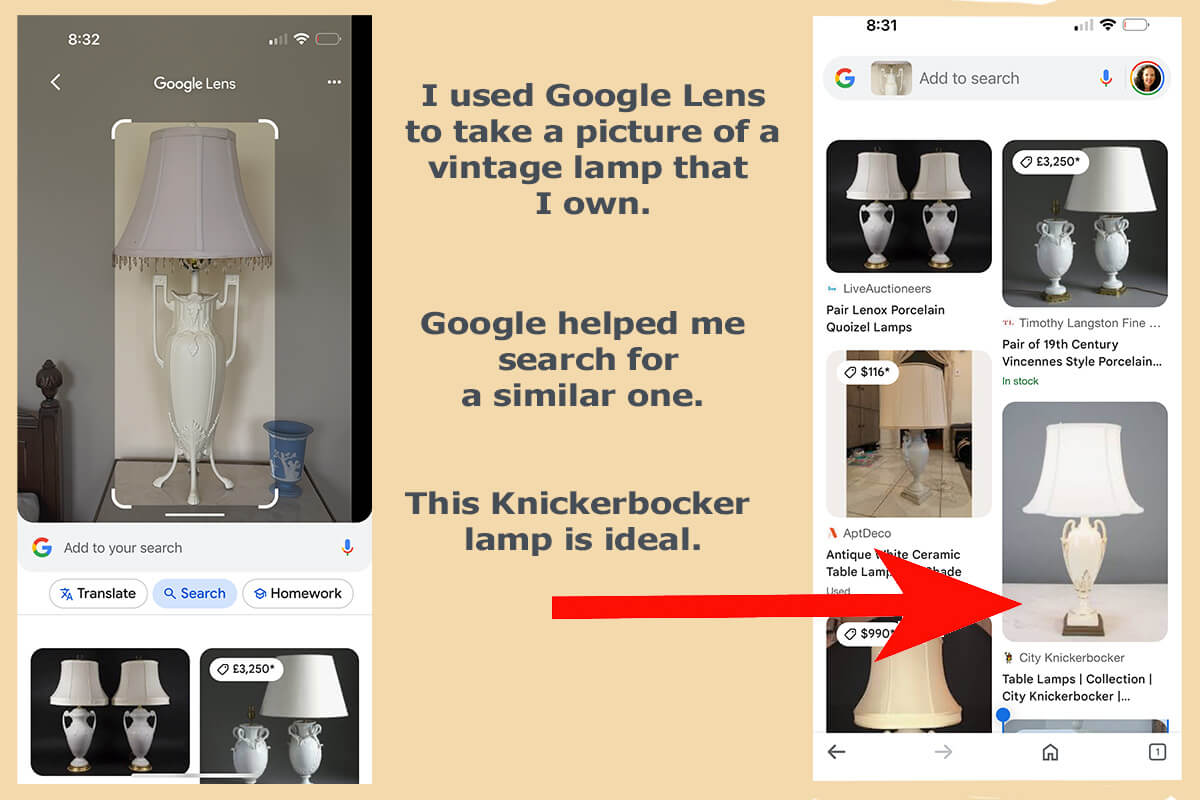
What are the differences between visual and textual e-commerce search?
The main differences when shopping using image search versus textual search:
- Ease: Google Lens is quick and easy to use. Just focus your iPhone camera on an object, click, and search.
- Accuracy: A picture provides color, shape, texture, and fine details. People typing a description into a search box often don’t do as well as describing a “thing” as a high-resolution image.
- Broader results: Information retrieval for a product search query provides exceptional performance from Google’s billions of cataloged images.
With better smartphone cameras and new technology behind ways to shop using the Internet, “Shop by image” has become more popular. It allows users to search by an image they take using their mobile device or upload from their photo library.
As of March 2024, smays.com estimates that Google Images will have 382 billion images by 2030. Being a Google Local Guide, I often upload images to support a review of something I bought, ate, or viewed on vacation. This adds to Google’s vast catalog of images to source and surface in search.
Visual, pictorial, or iconic search results produce additional imagery data that market researchers can analyze for future product management.
Visually-Rich Google SERP Features Assist Shoppers
The SERPs offer many ways to shop by image search, voice search, or use Shop with your Google Assistant)
Back in 2022 Google announced nine new ways it transformed how consumers visually shop with Google. They are:
- Search with the word “shop”.
- Shop the look.
- See what’s trending.
- Shop in 3D.
- Get help with complex purchases.
- See what other shoppers think.
- Get personalized features.
- Shop your way with new filters.
- Get inspired beyond the Search box.
To make sure Google understands your products, you need to use e-Commerce product schema markup. Think of it as a translator that tells search engines what your product is all about. When this information is included, Google can show more details about your products in shopping results, like prices, availability, and even star ratings. This helps your products stand out and make it easier for customers to find what they are looking for, which can lead to more sales.
The page that a search engine displays following a summited search query may include:
- Organic search results.
- Paid search.
- Pay-per-click (PPC) ads.
There are multiple formats that each of the above may take. Shoppers can filter results by type, brand, retailer, color, model, make, nearby, what’s on sale, and more.
Google states that its new shopping search experience will surface when people search for clothes, electronics, beauty products, or home goods. We expect this to expand from what we’ve heard at SearchOn 2022 and other events. Google also revealed that its results and filters for shopping searches are dynamic. Meaning, that they’ll continually change and display the freshest content.
We now find Google showing products that businesses add to the Google Business Profile manager directly in the Google Shopping tab within organic search results.
How does this impact business owners and marketers?
Invest more in your product pictures’ quality and include desirable on-page details that are of high interest to your potential clients. You want to present your products professionally and stand out among your competition in the search results! Since these new features empower shoppers before navigating to a website, their shopping experience is easier, more intuitive, informed, and fun. Whether they end up buying from your business can only happen if you show up.
Important Takeaway
Google remains consistent and places top importance on what its users want. It also favors sites with a strong reputation in search history to be confident of the results its returns. How searchers respond to its SERPS provides essential and meaningful information. This is why the tech giant is constantly exploring how to display helpful information. The introduction of new features and design elements is part of its response to make search more valuable to people.
Keeping your domain and content details correct, findable, and easy to source in SERPs is a top SEO consideration. Being highly visible in Google Shopping Results improves rankings, and increases brand recognition and ultimately sales.
We’ll assume that you are already publishing the best product pages possible. What’s next?
How to Optimize your Products for Winning Rich Results
Ecommerce rich results help shoppers visualize product options before committing to a clink.
- Know How Your Ideal Buyer Finds Products
- Product Schema Markup Expands Visibility in Google Shopping Results
- Leverage Additional Google Shopping Result Features
- Maximize New SERPs to Find the Right Buyer
- Make the Most of Your Product’s Images
- Shopping Actions on Google SERPs
Your SERP analysis will reveal how often your products to show up on Google. You can gain key answers to questions your potentional consumers are asking. Are your competitors getting SERP rich results you desire? When you view your products in search results are you pleased or do they look boring? Are you making the most of Google Shopping’s organic search features?
1. Know How Your Ideal Buyer Finds Products
Consumers use Google Search with the word “Shop” for easy shopping on Google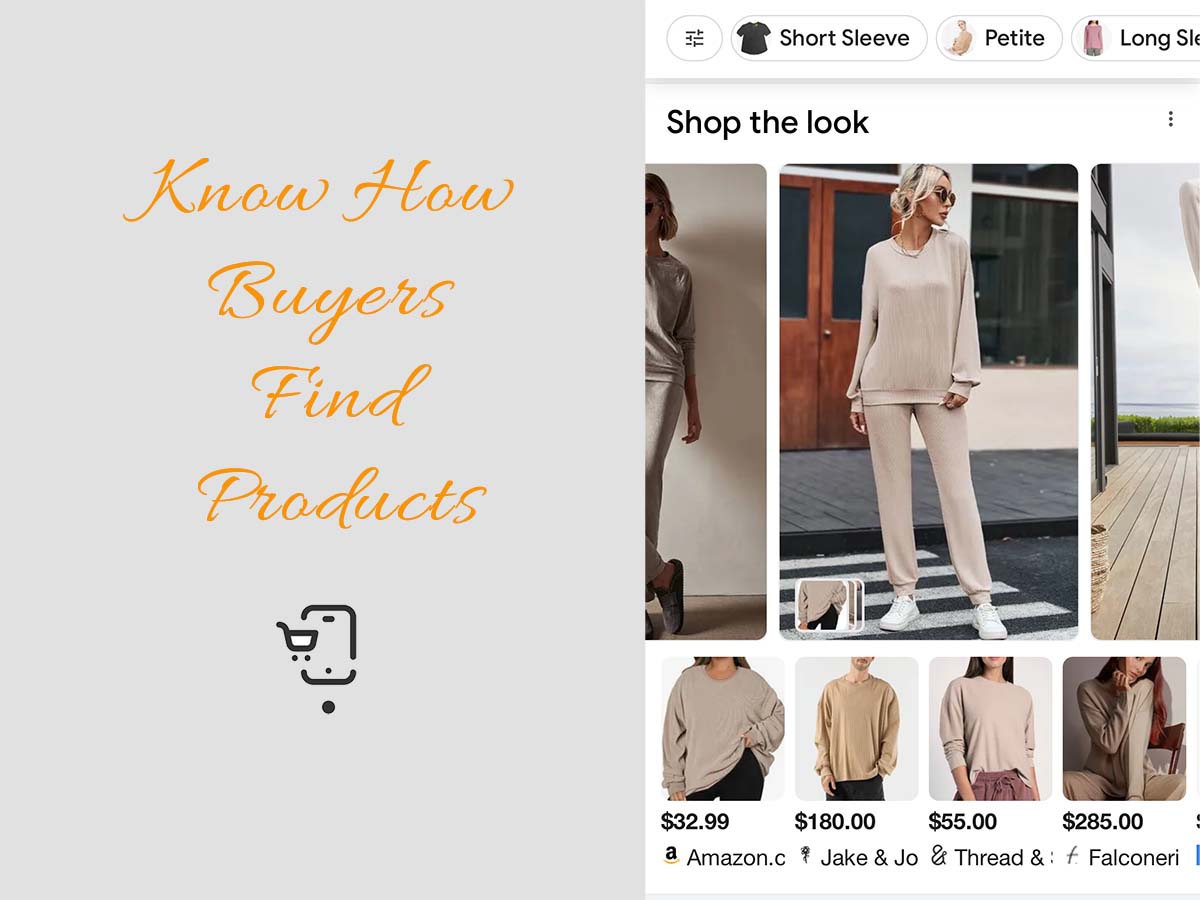
By starting your search with “shop” followed by what you’re searching for, you’ll now see a visual feed that includes products, research tools, and nearby inventory. This update also expands the shopping experience beyond clothing apparel. For mobile shoppers, everything is available in all categories. Google recognizes that buyers invest time upfront in researching, exploring, and discovering their purchase options before making a decision. These visual features are very helpful.
Google’s announcement about “Shop the look” applies to when search intent indicates the apparel category, shoppers can leverage “shop the look” which showcases relevant and unique products to assist in create an entire outfit. Google’s tool will suggest additional products to by along with the main product a person is searching for. Scarfs, belts, purses, and shoes or boots come to mind. [1]
When your product data includes SKUs, GTINS, and other product identifiers, potential customers can find your products in search. Search engines can understand your products better. Adding this information to your product pages in a way machine learning can process is essential SEO! By feeding Google all the information about your products you can reach your goals.
2. Product Schema Markup Expands Visibility in Google Shopping Results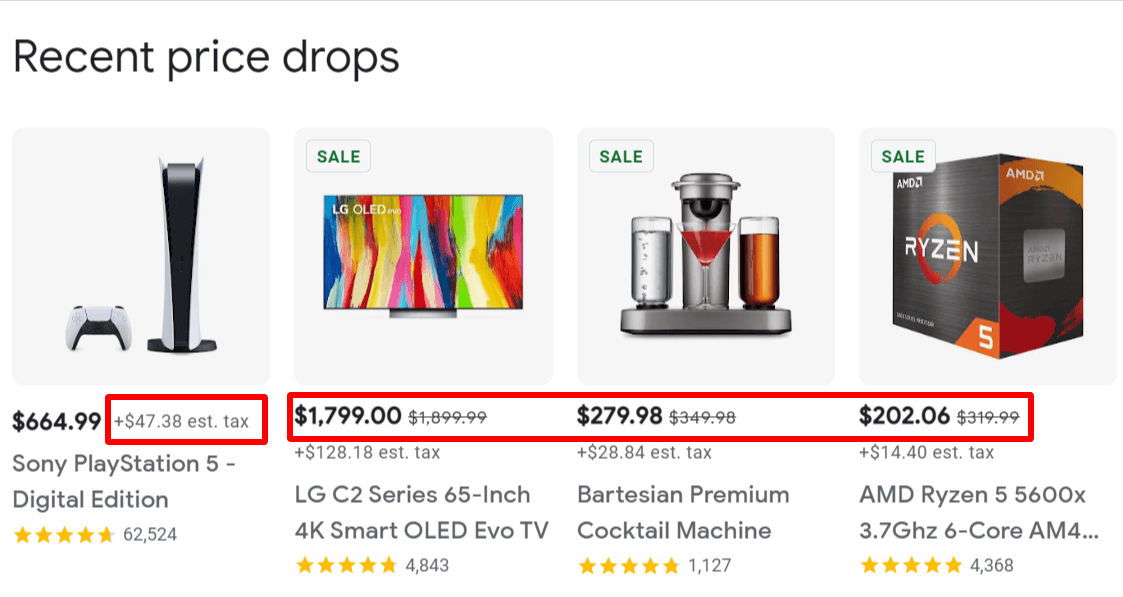
Google continues to expand eligibility for enhanced product experiences to sites using Product structured data.
In 2025, schema markup continues to benefit shoppers by providing readily available, detailed product information directly in search results. Consumers want faster, more informed purchasing decisions. This may or may not include navigating to individual websites. It’s more about improving their overall shopping experience and potentially leading to higher conversion rates for retailers.
Think of someone shopping for a medical device. As a person scrolls further down a Google SERP page, they see more unique search features and product information. Typically, these are powered by your valid product schema markup and Google Merchant Center optimization. Product images now often include more shopping details.
So, what are the product details that shoppers can see directly in Google Shopping?
Rich results that may display in Google Shopping SERPs:
- Shipping cost.
- Availability.
- Price range.
- Recent price drops.
- Estimated tax.
- Review count and ratings.
- Returns policy.
How to Optimize Product Listings for Conversions
Address customer concerns, provide a clear call to action on each product listing, and provide live chat on key pages. Well-written, persuasive, and detailed product descriptions that highlight product features, benefits, and unique selling points do a lot of heavy lifting to assit potential customers’ purchase decisions.
When a shopper clicks on one product carousel image, they gain more information about that item without interrupting their search. Clicking on one product carousel image will display a panel on the right with links to retailers who sell the product. As Google offers more details within its own real estate, buyers read reviews, find details that lead to what they want, and browse their favorite merchants straight in the SERPs. If they don’t know your brand already, your product images in Google Shopping Results can generate leads and brand introductions.
Return policy-rich snippets are drawn from Merchant Center feeds. Meaning, it’s important to research what shoppers want to drive better conversion rates. This is time better spent than overly watching keyword rankings.
3. Leverage Additional Google Shopping Result Features
- Google Search Console (GSC) reports now has enhanced Shopping section details to help businesses with a Merchant Center account to monitor the status of their products and discover opportunities to improve the visibility of their products on Google.
- Preowned product labels: Google shopping results started to show the “Preowned” label in SERPs for used merchandise.
- Advances in Intelligent Search: Every search engine wants to be the most useful at getting customers straight to the product they want to purchase. The race to be the search engine that uses Generative AI the best is intense.
- Intelligent recommendation: Leveraging AI-powered SERP recommendations using visuals for faster finds.
- “Search within Chrome”: Shoppers can now also find a new side panel “Search within Chrome”. It makes browsing through results faster, which is a bonus for online shopping.
- Google Shopping Tab Includes GBP products: Google has added showing products directly in Google Shopping search results that have been added through the Google Business Profile manager.
- Recommended product images: Google Chrome (iOS)’s Discover feed has a new card type labeled “Image Recommendations”. Clicking it takes you to Google image search where you can find a collection of product images related to your query.
- Price comparisons: “Price Drop Rich Result” is part of the mobile display for e-commerce category pages as well as price comparisons. “We’re bringing our price insights feature to Search to help shoppers understand the prices they see and make better buying decisions. Now, you’ll quickly see how one merchant’s price compares to others and whether it’s low, typical, or high for that product.” – Google [2]
New SERP features that switch up Google Shopping Results are emerging at quite a clip. They are non-traditional SERPs that increase the visual experience when searching.
“Google has multiple surfaces where your eCommerce content can appear, such as in search results and on Google Maps. Providing the right content on the appropriate Google surface can help you reach new potential customers.” – Google Docs [3]
4. Maximize New SERPs to Reach More Buyers
There is a lot more to it than just setting the right price. Shoppers want choices. For individuals following the emerging Google Search Generative Experience, we anticipate shoppers will gain more ways to find products faster.
“And the thing that doesn’t change with these [shopping] experiences is that a lot of user journeys are commercial in nature, there are inherent commercial user needs. And what’s exciting to me is that SGE gives us an opportunity to serve those needs, again, better.
So it’s clearly an exciting area and as part of that, the fundamentals don’t change. The users have commercial needs and they are looking for choices, and there are merchants and advertisers looking to provide those choices, so those fundamentals are true in SGE as well.”
– Sundar Pichai, CEO of Google and Alphabet, during Alphabet 2023 Q2 Earnings Call [4]
Why Retailers Need to Care: Opportunity
The first of January 2025, Jack Shepherd wrote that “98% of global consumers who were surveyed reported that they shopped online. This includes browsing, researching, and actually making a purchase.” His 19 Essential Google Ads & PPC Statistics You Need to Know in 2025 article talks about how people enjoy the ability to shop from the comfort of their own homes.
A history of progress is demonstrated in the August 15, 2023 U.S. Census Bureau, Advanced Monthly Retail Trade Survey [8]. It stated that “retail trade sales were up 0.6 percent (±0.5 percent) from June 2023, and up 2.0 percent (±0.5 percent) above last year.”
These statistics from the United States Economic Indicators Division, Retail Indicator Branch point to increased retail sales. Apparently, people are still buying regardless of talk about a recession.
Google Shopping is a key way that businesses that can increase their share of sales.
“SERP composition changes seem to make room for product listings, as merchant listings grew by 16% and comprised 45% of the total composition. It’s safe to say that 2023 will be the year of the product listing: if we consider all product listing types, about 50% of all retail SERP elements are products.” – Merkle [5]
5. Make the Most of Your Product’s Images
High-quality images help you get in the shopping tab. Here shoppers have dynamic filters that can lead them to product information most related to their intent. SERP visual displays vary based on personalization and the searcher’s history. The effort is worth it because more ways to buy on the SERP are increasing.
Google may elect to pull images from multiple places:
- Video or image-rich consumer reviews.
- Web pages linked to within its search results.
- From product landing pages.
- Anywhere you specify a product image correctly within product schema markup.
Shopping is much about product research before it is about buying. This is where most consumers begin – exploring options on the SERP. Image-rich featured snippets let people discover new styles, colors, patterns, product features, and trends. Your products need to shop up in the research phase.
Today, digital shoppers can immediately see what a product looks like at start at the right price point for their budget. To be competitive, retailers who embrace this new more immersive, informed, and personalized shopping experience can take a lead.
Hill Web Marketing is exciting to offer services to maximize these traditional and new ways to find new buyers. We are eager to partner if you are serious about growing your business revenue.
6. Shopping Actions on Google SERPs
Google offers buyers a ‘shop deals’ banner for many United States queries. This is why you should ensure that your product grids and Merchant Center product data are current and accurate.
A price slider filter for products is also frequently displayed in search results. Additionally, a Google Search store button filter helps buyers filter by retailer merchants. Stay current on what is occurring for your brand SERP. Search is also a branding channel; retailers will find this keeps your brand at the top of mind
Competitor options are also displayed.
Let’s take a look at what’s new.
New Google Shopping Features in 2023
Buyer intent data opens up new opportunities to improve sales and marketing strategies that take advantage of newer retail SERP opportunities. Ready buyers are within reach when reliable intent data is integrated into your sales playbook.
- 🔎 Buyers can search for products using Google’s ShopTheLook Lens.
- 🔎 “Buy now” located in Google’s popular product pack can add the product directly to your shopping cart from Google search.
- 🔎 Google “People Also Buy From” Section in its SERPs.
- 🔎 A new small business shopping filter emerged. Tap on “Small business” under the “Filter by” section, and shoppers get fresh results all about small businesses.
- 🔎 The ability to “Shop Deals” and perform price tracking emerged before the holidays. Users can elect to receive emails for price drops. View your saved and tracked items in your Shopping list folder located in the side panel.
- 🔎 Users can trigger a new Google Shopping toggle “on” or “off” feature.
- 🔎 Google tested Google Shopping Labels On search result snippets.
- 🔎 Google’s shopping filter is also displaying for some local queries. This occurs when there is shopping intent in that query. We classify this as more of a shopping filter than a local one.
- 🔎 Google added a “get style recommendations” feature earlier in the year. Now shoppers can swipe left and right on those style recommendations if using mobile search. Following several multiple left and right, you see a carousel of product results for fresh selection options.
Google is providing the buyer with more information directly on its SERP
For instance, if a person is conducting a search for Breville One-Touch Tea Maker and wants brewing tips, search can assist similar to People Also Search For and Related Searches where purchasers gain additional dropdown filters to gain more ideas.
Buyers now gain more SERP features that are more real-time. Also, they find overlaid SERP features on Google Maps. We anticipate this Google shopping trend will expand in 2024. Meaning that the future of SERP features isn’t only about them expanding; it’s that they’re becoming more clever and personalized. The sophisticated tech giant uses many data sources to determine how to enhance the shopping experiences its SERPs offer.
Shopping Tabs Listing Feature and Store Icons
Google is displaying new store icons and labels for entities that adhere to Top Quality Store requirements. Similiar mobile SERPS have been previously tested. However, the ‘Star Store’ label and icons are newer.
Mobile SERPs have been visually richer for some time. Now search results for shopping-related queries on desktops are becoming more visual, too. Retail is definitely expanding on the SERP! This offers more ways you can also win clicks from Google’s real estate.
“Last month we announced several new features coming to Google, including more visual ways to shop on mobile. And now, in the U.S., we’re bringing you a more visual shopping experience on a desktop. – Shoppable Search on Desktop – Google Blog
“Cool to see more sites receiving the Shopping Tab Listings feature in GSC. A few just showed up for some more properties. A great way for some companies to quickly get their products in the Shopping Tab, even without a merchant center feed. Just need structured data.” – Glenn Gabe on Twitter [6]
NOTE: Google’s Shopping Resuts states “We’re making changes to saves and price tracking. Learn how you can still access these features.” Personally, I believe we’ll see more exciting changes coming in 2024.
Google Shopping Pre-Owned Green Leaf Labels
Google may display a green leaf label that says “pre-owned” on Google Shopping results. We find them in both in desktop and mobile shopping results. This is an awesome feature for second-hand shops or consignment shops.
Be prepared in both organic and paid search results; learn more about ad formats for achieving better retail results. On September 11, 2023, Associate Search Console to Merchant Center to discover growth opportunities were announced. This is super helpful as we can receive notifications when client products stop appearing on the Shopping tab due to any issues. [7]
CONCLUSION: Shoppers Benefit Significantly from AI Product SERPs
We are constantly researching new ways to help our clients increase sales. .
Call Jeannie Hill at 651-206-2410 if you’d like to partner and develop your retail business’s Search Marketing Strategies
References
[1] https://blog.google/products/shopping/search-on-2022-shopping/
[2] https://techcrunch.com/2022/11/01/google-search-new-shopping-features-get-better-deal/
[3] https://developers.google.com/search/docs/specialty/ecommerce/where-ecommerce-data-can-appear-on-google
[4] https://www.youtube.com/watch?v=uH56EFVIkDc
[5]
https://searchengineland.com/the-strategic-search-revolution-is-here-how-to-better-engage-your-audience-429078
[6] https://twitter.com/glenngabe/status/1597575111510466565
[7] https://developers.google.com/search/blog/2023/09/search-console-merchant-center-association
[8] https://www.census.gov/retail/marts/www/marts_current.pdf” title=”Census Bureau, Advanced Monthly Retail Trade Survey
